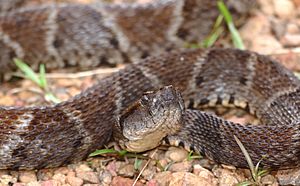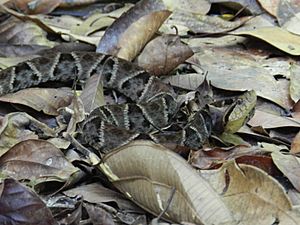Bothrops atrox facts for kids
Quick facts for kids Bothrops atrox |
|
|---|---|
 |
|
| Conservation status | |
| Scientific classification | |
| Genus: |
Bothrops
|
| Species: |
atrox
|
| Synonyms | |
|
|
The common lancehead (scientific name: Bothrops atrox) is a very venomous pit viper snake. It is also known by names like fer-de-lance, barba amarilla (yellow beard), and mapepire balsain. This snake lives in the warm, low-lying areas of northern South America, east of the Andes mountains. You can also find it on the Caribbean island of Trinidad.
Contents
What is a Common Lancehead?
The common lancehead is a type of reptile that was first described by a famous scientist named Carl Linnaeus in 1758. He gave it the scientific name Coluber atrox. Scientists sometimes debate if some similar snakes are actually the same species or different ones. For example, the B. asper snake used to be considered the same, but now most experts agree it's a separate species.
Different Names for the Snake
This snake has many different names depending on where you are.
- In Spanish, it's often called barba amarilla, which means "yellow beard." This name comes from its pale yellow chin.
- In Venezuela, people call it mapanare.
- In Colombia, it's known as mapaná or talla equis.
- In Guyana and Suriname, it's called labaria or labarria.
- In Peru, it has many local names like jergón or jergona. The name jergón refers to the X-shaped patterns on its body.
- In Ecuador and Panama, because of these X-shaped markings, it's simply called equis, which is the Spanish word for the letter 'x'.
- On the island of Trinidad, it's known as mapepire balsain.
- In Bolivia, it's called Yoperojobobo.
- In Brazil, common names are Jararaca or Jararaca-do-norte.
How to Identify a Common Lancehead
The common lancehead is a snake that lives on the ground. Adult snakes usually grow to be about 75 to 125 centimeters (30 to 50 inches) long. They have a moderately thick body. Some very large females have been measured at over 160 centimeters (about 5 feet 4 inches).

The snake's color can change a lot. It might be olive green, brown, tan, gray, yellow, or sometimes even rusty red. The patterns on its body are also very different from one snake to another. Some have clear, bold markings, while others might have very faint patterns.
Generally, the snake has a series of blotches (large spots) along its back. These blotches can be rectangular or trapezoid-shaped. They often connect to form bands across the body. These markings usually have light edges. The snake's belly is typically white, cream, or yellowish-gray. It might have more gray or black spots towards its tail.
The head usually doesn't have many markings, except for a stripe that goes from behind its eye to the corner of its mouth. Its eyes are gold or bronze, and its tongue is black.
Where Common Lanceheads Live
This snake lives in the tropical lowlands of South America, east of the Andes mountains. This includes countries like southeastern Colombia, southern and eastern Venezuela, Guyana, Suriname, French Guiana, eastern Ecuador, eastern Peru, Panama, northern Bolivia, and the northern part of Brazil. It is also found on the island of Trinidad.
Even though many rainforests are being cut down, the common lancehead is still one of the most common pit vipers and is not considered an endangered species. In Trinidad, it prefers wet forests, from sea level up to about 940 meters (3,084 feet) high.
Snake Behavior
Even though these snakes mostly live on the ground, they are also very good swimmers. They can even climb trees if they need to catch prey. They are usually active at night, but they can hunt at any time of day if necessary. These snakes can also get agitated or upset quite easily.
What They Eat
The common lancehead mainly eats small mammals, like rodents (such as mice and rats) and opossums. They also eat birds, frogs, lizards, smaller snakes, fish, centipedes, and even tarantulas. When they bite larger prey, they usually strike and then let go. After that, they follow the scent trail of the bitten animal to find it.
How They Reproduce
Female common lanceheads give birth to live young, not eggs. They can have up to 80 babies at one time! Adults can breed all year round. After mating, the female snake will move in and out of sunlight to keep her body and the developing babies inside her at a steady, warm temperature.
In areas near the equator, the babies grow inside the mother for about three to four months. On average, a mother snake will have about 60 young in one litter. When they are born, the young snakes are about 30 centimeters (12 inches) long. They are usually brighter in color than the adult snakes and have yellow or beige tails.
About Their Venom
Common lanceheads are often found in places like coffee and banana farms because they hunt for rodents there. Farm workers can sometimes be bitten by these snakes. The snakes are very good at hiding and can strike very quickly.
The venom of the common lancehead mainly affects a person's blood. It can cause serious bleeding and make it hard for blood to clot normally. If someone is bitten, they need medical help right away. The bite can cause pain, bruising, headaches, and an upset stomach. In some serious cases, it can lead to problems with the kidneys or even affect the brain.
Scientists have found that the venom from younger snakes might cause more swelling and be more dangerous than the venom from adult snakes. On average, a common lancehead can produce about 124 milligrams of venom, but some can produce up to 342 milligrams.
Interestingly, a special enzyme called reptilase (also known as batroxobin) comes from this snake's venom. This enzyme is used in medical labs to check how well a person's blood can clot. It's a useful tool for doctors to understand blood health.
See also
 In Spanish: Jergón para niños
In Spanish: Jergón para niños


